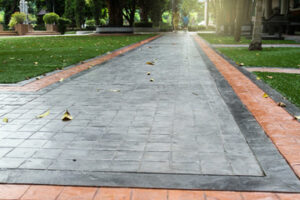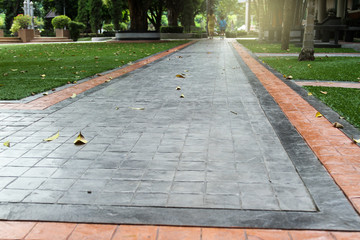You may be interested in trying stamped concrete for your driveway, but you need to be aware of a few things before committing. If you’ve ever wondered what the difference is between stamped concrete and ordinary concrete, this article will give you an overview of what makes the difference. Stamped Concrete requires a thicker slab and a stronger concrete mix than regular concrete. While the stamping process can produce a realistic effect, it’s best to hire a professional for this.
 You can use many different stamping techniques to create a striking and exciting surface. Often, a concrete stamp is created to mimic the look of a certain type of material. Stamped concrete can also be very subtle, with only a small amount of texture. For example, using a stone effect pattern to create a flagstone pattern can create a striking surface. Stamped concrete can also be used to create a flowing front yard. A stamped walkway or driveway can add a classy, sophisticated feel to any property.
You can use many different stamping techniques to create a striking and exciting surface. Often, a concrete stamp is created to mimic the look of a certain type of material. Stamped concrete can also be very subtle, with only a small amount of texture. For example, using a stone effect pattern to create a flagstone pattern can create a striking surface. Stamped concrete can also be used to create a flowing front yard. A stamped walkway or driveway can add a classy, sophisticated feel to any property.
Stamped concrete requires little maintenance compared to asphalt or natural stone. Unlike asphalt, it doesn’t need to be sealed, and it won’t fade over time. Another important advantage is its cost. Because it’s made from concrete, stamped concrete requires a lower price than other paving materials. The cost per square foot is typically around $100. Stamped concrete also tends to last a long time. A patio area typically requires resurfacing every five to seven years.
Stamped concrete can be colored with various methods. It has two colors, the base color and an accent color in most cases. The base color of new concrete is produced by adding a color hardener, which is a powder pigment. The base color will be accented and contrasted, making it look better than paved stone. If you’re unsure about which color you want, consult with your contractor or distributor.
Stamped concrete has many uses and can be combined with other decorative concrete elements such as exposed aggregate or acid staining. Stamped overlays can be used for new homes and revitalizing old concrete floors. In addition to floors and walls, stamped patterns can also be imprinted on concrete countertops. Stamped concrete provides complete customization. The advantages of stamped concrete include its low cost and the fact that it can be incorporated into many home decors.
When choosing a pattern for stamped concrete, there are five main categories: brick, stone, wood, and slate. The types of patterns can vary depending on your preference and your home’s hardscape. For best results, choose a pattern that complements your home’s architectural style and the rest of your landscaping. Once you’ve decided, the next step is to choose the right stamps for your concrete project. If you’re not sure which one will work best for your home, consider getting a professional to do it for you.
If you want to use colored concrete, you must make sure that it has a good color release agent. There are two types of color release: powder and liquid. Powder color release is made of calcium-releasing materials that repel water. Liquid color release is made of a light aromatic solvent and spreads on the surface of the concrete before stamping. The powder form is applied to the bottom of the concrete stamps. It is important to check the plasticity of the concrete before stamping. Otherwise, the stamped concrete may not be strong enough to support weight or retain the imprint.
The main difference between plain concrete and stamped concrete is that the former is less durable. Regular concrete can last up to 25 years, while stamped concrete can last for decades. The main difference is that a regular concrete can have hidden cracks that will eventually affect the stamped surface. These cracks will cause further damage to the concrete and need to be repaired. Then, you can apply a new coat of concrete sealing to preserve the beauty and luster of your stamped concrete.
If you don’t want to make your concrete patio last as long as slab concrete, you can consider installing interlocking pavers on the surface. They’re slightly more expensive, but they require very little maintenance. And unlike slab concrete, you won’t need to replace the entire surface if some pavers crack. You can also replace individual pavers if they get damaged or fall out of place. And because they’re cheaper than precast pavers, they’re an excellent alternative if you’re not ready to commit to stamped concrete.
